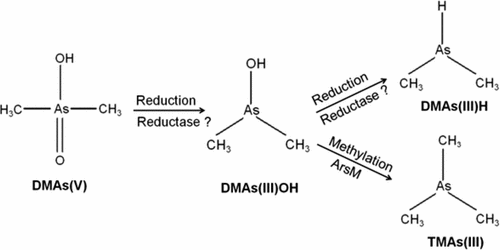当前位置:
X-MOL 学术
›
Environ. Sci. Technol.
›
论文详情
Our official English website, www.x-mol.net, welcomes your
feedback! (Note: you will need to create a separate account there.)
Microbial Processes Mediating the Evolution of Methylarsine Gases from Dimethylarsenate in Paddy Soils
Environmental Science & Technology ( IF 10.8 ) Pub Date : 2017-11-10 00:00:00 , DOI: 10.1021/acs.est.7b04791 Chuan Chen 1 , Ke Huang 1 , Wan-Ying Xie 1 , Si-Hong Chen 1 , Zhu Tang 1 , Fang-Jie Zhao 1
Environmental Science & Technology ( IF 10.8 ) Pub Date : 2017-11-10 00:00:00 , DOI: 10.1021/acs.est.7b04791 Chuan Chen 1 , Ke Huang 1 , Wan-Ying Xie 1 , Si-Hong Chen 1 , Zhu Tang 1 , Fang-Jie Zhao 1
Affiliation

|
Arsenic (As) biovolatilization is an important component of the global As biogeochemical cycle. Soils can emit various methylarsine gases, but the underlying microbial processes remain unclear. Here, we show that the addition of molybdate (Mo), an inhibitor of sulfate-reducing bacteria, greatly enhanced dimethylarsine evolution from dimethylarsenate [DMAs(V)] added to two paddy soils. Molybdate addition significantly affected the microbial community structure. The aerobic enrichment cultures from both soils volatilized substantial amounts of dimethylarsine from DMAs(V) in the presence of Mo, whereas the anaerobic enrichment cultures did not. A Bacillus strain (CZ-2) capable of reducing DMAs(V) to dimethylarsine was isolated from the aerobic enrichment culture, and its volatilization ability was enhanced by Mo. RNA-seq analysis identified 10 reductase genes upregulated by Mo. Addition of the reducing agent NADH increased dimethylarsine volatilization by strain CZ-2, suggesting that DMAs(V) reductase is an NADH-dependent enzyme. The strain could not methylate arsenite or convert monomethylarsenate and DMAs(V) to trimethylarsine. Our results show that dimethylarsine evolution from DMAs(V) is independent of the As methylation pathway and that Mo enhances dimethylarsine evolution from paddy soils by shifting the microbial community structure and enhancing the reduction of DMAs(V) to dimethylarsine, possibly through upregulating the expression of DMAs(V) reductase gene(s).
中文翻译:

介导稻田土壤中二甲基砷酸甲基ate产生的微生物过程
砷生物挥发是全球砷生物地球化学循环的重要组成部分。土壤会释放出各种甲基ar气体,但潜在的微生物过程仍不清楚。在这里,我们表明,添加硫酸盐(细菌)的抑制剂钼酸盐(Mo)大大增强了从添加到两个稻田土壤中的二甲基砷酸二甲酯[DMAs(V)]生成的二甲基ar氨酸的过程。钼酸盐的添加显着影响了微生物群落结构。在有Mo的情况下,两种土壤的需氧富集培养物均挥发了DMAs(V)中的大量二甲基ar,而厌氧富集培养物则没有。一个芽孢杆菌从需氧富集培养物中分离出能够将DMAs(V)还原为二甲基ar的菌株(CZ-2),并通过Mo增强了其挥发能力。RNA-seq分析鉴定了Mo上调的10个还原酶基因。 CZ-2菌株增加了二甲基ar的挥发,表明DMAs(V)还原酶是一种依赖NADH的酶。该菌株不能将亚砷酸甲基化或将单甲基砷酸和DMAs(V)转化为三甲基ar。我们的结果表明,DMAs(V)产生的二甲基ar与As甲基化途径无关,并且Mo通过改变微生物群落结构和增强DMAs(V)还原为二甲基ar的方式而增强了水稻土中二甲基ar的进化,这可能是通过上调表达来实现的。 DMAs(V)还原酶基因的合成。
更新日期:2017-11-11
中文翻译:

介导稻田土壤中二甲基砷酸甲基ate产生的微生物过程
砷生物挥发是全球砷生物地球化学循环的重要组成部分。土壤会释放出各种甲基ar气体,但潜在的微生物过程仍不清楚。在这里,我们表明,添加硫酸盐(细菌)的抑制剂钼酸盐(Mo)大大增强了从添加到两个稻田土壤中的二甲基砷酸二甲酯[DMAs(V)]生成的二甲基ar氨酸的过程。钼酸盐的添加显着影响了微生物群落结构。在有Mo的情况下,两种土壤的需氧富集培养物均挥发了DMAs(V)中的大量二甲基ar,而厌氧富集培养物则没有。一个芽孢杆菌从需氧富集培养物中分离出能够将DMAs(V)还原为二甲基ar的菌株(CZ-2),并通过Mo增强了其挥发能力。RNA-seq分析鉴定了Mo上调的10个还原酶基因。 CZ-2菌株增加了二甲基ar的挥发,表明DMAs(V)还原酶是一种依赖NADH的酶。该菌株不能将亚砷酸甲基化或将单甲基砷酸和DMAs(V)转化为三甲基ar。我们的结果表明,DMAs(V)产生的二甲基ar与As甲基化途径无关,并且Mo通过改变微生物群落结构和增强DMAs(V)还原为二甲基ar的方式而增强了水稻土中二甲基ar的进化,这可能是通过上调表达来实现的。 DMAs(V)还原酶基因的合成。











































 京公网安备 11010802027423号
京公网安备 11010802027423号